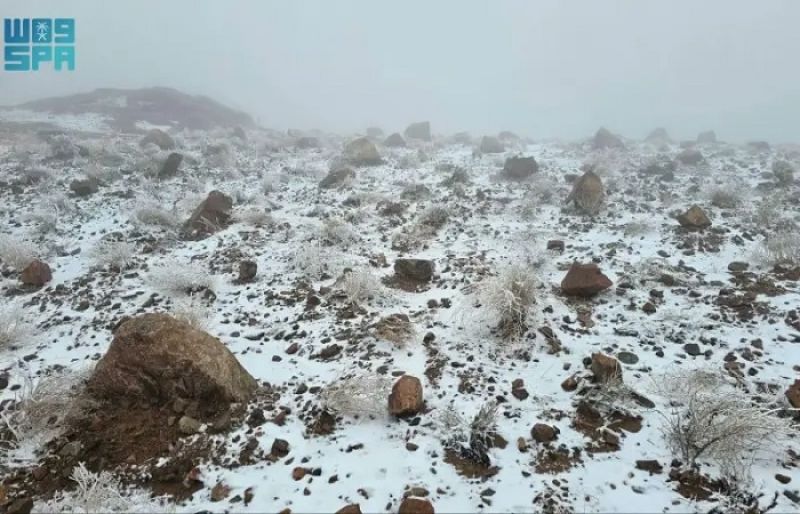Politics
Trump warns there ‘could be’ US troops on ground in Nigeria, or air strikes


- Says Christians are being killed in record numbers in Nigeria.
- Vows the US will intervene to bring the violence to an end.
- Threatens military action against North African country.
US President Donald Trump said on Sunday that the US military could deploy troops to Nigeria or carry out air strikes to stop what he called the killing of large numbers of Christians in the West African country.
Asked if he envisioned troops on the ground or air strikes in Nigeria, Trump told reporters aboard Air Force One: “Could be. I mean, other things. I envisage a lot of things.
“They’re killing record numbers of Christians in Nigeria … They’re killing the Christians and killing them in very large numbers. We’re not going to allow that to happen.”
Trump made the comment on Sunday evening as he headed back to Washington after a weekend at his vacation home in Florida.
Trump threatened on Saturday to take military action against Nigeria if Africa’s most populous country failed to crack down on the killing of Christians.
The US president’s threat of military action came a day after his administration added Nigeria back to a “Countries of Particular Concern” list of nations that the US says have violated religious freedoms. Other nations on the list include China, Myanmar, North Korea, Russia and Pakistan.
No Tomahawks for Ukraine
On Ukraine, Trump said he was not really considering giving Ukraine long-range Tomahawk missiles. Asked by a reporter aboard Air Force One if he was not considering providing the weapons to Ukraine, Trump responded: “No, not really.”
On October 12, Trump had said he may offer long-range Tomahawk missiles that could be used by Kyiv if Russian President Vladimir Putin does not end the war in Ukraine.
Trump told reporters aboard Air Force One as he flew to Israel that he and Ukrainian President Volodymyr Zelenskiy discussed Zelenskiy’s request for weaponry, including Tomahawks.
Tomahawk missiles have a range of 2,500 km (1,550 miles), long enough to strike deep inside Russia, including Moscow.
The Kremlin has warned against any provision of Tomahawks to Ukraine, and Trump said they would be “a new step of aggression” if introduced into the war.
Trump avoids SC tariff arguments
He also said he will not attend the Supreme Court’s upcoming oral arguments concerning the legality of his global tariffs.
Justices have a Wednesday hearing scheduled for arguments on the tariffs case. Trump told reporters on Air Force One that despite his desire to be there, he does not want to create a distraction during the hearing.
“I wanted to go so badly,” Trump said as he flew back to Washington after a weekend in Florida. “I just don’t want to do anything to deflect the importance of that decision. … I don’t want to call a lot of attention to me. It’s not about me, it’s about our country.”
Arguments before the highest US court on Wednesday will centre on the legality of Trump’s sweeping global tariffs in a major test of one of his boldest assertions of executive power, regarding an issue that has been central to his economic and trade agenda.
The Supreme Court took up the Justice Department’s appeal of a lower court’s ruling that Trump overstepped his authority in imposing most of his tariffs under a 1977 law known as the International Emergency Economic Powers Act.
The tariffs were challenged by various businesses and 12 US states.
Trump defended his use of tariffs to balance global trade flows, citing years of high duties charged by other countries on US imports. He said his tariffs had increased US revenues and driven the stock markets to a series of record highs.
“If we don’t have tariffs, we don’t have national security, and the rest of the world would laugh at us because they’ve used tariffs against us for years and took advantage of us,” he said.
“We were subject to being abused by a lot of other countries, including China. For years, not anymore. Tariffs have brought us tremendous national security,” he said.
Politics
Trump administration suspends US green card lottery


- Noem says suspect entered via DV1 in 2017.
- USCIS ordered to pause programme immediately.
- Lottery awards up to 55,000 visas annually.
WASHINGTON: US homeland security chief Kristi Noem suspended a green card lottery on Thursday, saying it was used by the suspect in a mass shooting at Brown University.
Claudio Neves Valente, a 48-year-old Portuguese national, is accused of bursting into a building at the Ivy League school on December 13 and opening fire on students sitting exams, killing two and wounding nine.
He is also accused of killing a professor at the Massachusetts Institute of Technology (MIT) two days later.
Noem wrote on social media that Neves Valente “entered the United States through the diversity lottery immigrant visa program (DV1) in 2017 and was granted a green card.”
“At President Trump’s direction, I am immediately directing USCIS (United States Citizenship and Immigration Services) to pause the DV1 program to ensure no more Americans are harmed by this disastrous program,” Noem wrote.
“This heinous individual should never have been allowed in our country.”
Neves Valente was found dead by suicide after a days-long manhunt, police said on Thursday evening.
The US green card lottery grants up to 55,000 permanent resident visas annually to people “from countries with low rates of immigration to the United States,” according to the State Department.
To qualify, applicants must have at least a high school education or two years of training or work experience.
They also go through a vetting process that includes an interview.
Trump administration also intends to increase its efforts to strip some naturalised Americans of their US citizenship, the New York Times reported on Wednesday, citing internal guidance.
The USCIS guidance, which was issued on Tuesday, asks its field offices to “supply Office of Immigration Litigation with 100-200 denaturalisation cases per month” in the upcoming 2026 fiscal year, according to the newspaper.
The guidance comes as Trump has spent much of this year closing loopholes in the immigration system and throwing up roadblocks for people seeking to enter and stay in the country.
US President Donald Trump has carried out an aggressive immigration agenda, including imposing travel bans and an attempt to end birthright citizenship since January.
His administration most recently paused immigration applications, including green card and US citizenship processing, filed by immigrants from 19 non-European countries.
— With additional input from Reuters
Politics
Australia’s Head slams unbeaten 142 to crush England’s Ashes hopes


Danger man Travis Head crunched his fourth century in as many Tests at Adelaide Oval Friday as Australia built a 356-run lead over England to stand on the brink of retaining the Ashes.
The hosts were 271-4 at stumps on day three of the third Test with Head on 142 and first-innings century-maker Alex Carey not out 52, taking the five-match series out of England’s reach.
England must win after crashing inside two days at the first Test in Perth and inside four in Brisbane, both by eight wickets.
But it appears to be an impossible task with the highest run chase at the ground 316 by Australia against England in 1902.
Head’s crucial ton, his 11th, came off a composed 146 balls although he almost didn’t get there, dropped on 99 by Harry Brook as impatience got the better of him.
He has now scored a century in four consecutive Tests on his home ground, following 140 against India last year and 119 and 175 against the West Indies.
Australia suffered an early setback in a tense 20 minutes before lunch after England were all out for 286 on the back of Ben Stokes’ gritty 83 in response to Australia’s first innings 371.
Bryson Carse trapped Jake Weatherald lbw for one and he walked without reviewing after the umpire lifted his finger, although replays showed the ball was pitching outside leg stump.
It gave England a glimmer of hope, but after the break Head slammed the door shut, cutting and chopping boundaries to all corners of the ground.
Marnus Labuschagne went for 13 when he edged Josh Tongue to Harry Brook at slip, with reviews showing it carried.
Usman Khawaja, who hit a defiant 82 in the first innings after his last-minute call-up for the ill Steve Smith, was a perfect foil for the more aggressive Head.
But on 40 he was undone by the spin of Will Jacks, caught behind, and Cameron Green followed soon after for seven, edging Tongue to Brook.
After getting through the nervous 90s, Head finally brought up his century with a four off Joe Root, taking off his helmet and kissing the turf before pumping his fists.
While not in the same vein as his match-winning 69-ball century in Perth, it was a critical knock, supported by Carey and aided by Stokes not bowling after his exploits with the bat.
Gutsy Stokes
After a woeful batting display on Thursday, Stokes and Jofra Archer kept England’s dreams alive with a stirring 106-run ninth-wicket stand.
They resumed at 213-8 in muggy conditions with Stokes not out 45 and Archer on 30.
Stokes, who suffered leg cramps and dehydration during his gutsy rearguard action in sweltering 40 Celsius heat on Thursday, brought up his slowest ever 50 in Tests, off 159 balls.
England’s Ben Stokes (L) and Jofra Archer run between the wickets on the third day of the third Ashes cricket Test match between Australia and England at the Adelaide Oval in Adelaide on December 19, 2025. — AFP
He kept plugging away but finally fell when Mitchell Starc took the new ball and bowled him, with Stokes one of the few players who showed the fight he had demanded before the game.
Archer was another, ably helping his captain.
The fast bowler was the last man out when caught by Labuschagne off Scott Boland for 51 — his highest Test score and a maiden half-century Boland ended with 3-45 while Pat Cummins took 3-69 in his first Test since July.
England’s woes began when openers Zak Crawley and Ben Duckett, along with the under-performing Ollie Pope, departed in a 15-ball blitz on Thursday at the hands of Cummins and Nathan Lyon.
Harry Brook showed some resistance with 45, but the Australian attack was relentless.
Politics
Saudi Arabia, Qatar have a white winter as snowfall hits northern areas


According to Khaleej Times, a period of low-pressure systems in the Middle East has brought heavy rainfall over the last week. Conditions were forecast to intensify on Thursday, with thunderstorms expected to hit the region.
The storm was then forecast to move eastwards towards the UAE and Qatar by night, it added, citing BBC Weather.
Khaleej Times reported that large areas of Qatar had also been covered by snowfall already, sharing a video of the landscape.
In Saudi Arabia, snow and light rainfall were experienced in Trojena, a mountain destination for hiking and skiing located on Jebel Al-Lawz in the province of Tabuk that reaches up to 2,600 metres, according to Arab News.
Additionally, light to moderate rain was experienced in Bir Bin Hermas, Al-Ayinah, Ammar, Al-Ula Governorate and Shaqra and its suburbs. Several other regions, including Riyadh, also experienced moderate to heavy rainfall, the outlet added.
Riyadh experienced thick cloud cover and rainfall from early yesterday. According to Arab News, all schools in the Saudi capital switched to remote learning amid the continuing inclement weather.
“The Qassim Region, including the city of Buraidah, experienced moderate to heavy rainfall, while Tabuk Region experienced light to moderate rainfall on Thursday,” it said, citing the Saudi Press Agency (SPA).
“Parts of Hail region also witnessed snowfall on Wednesday evening in areas surrounding the city of Hail, while light to moderate rainfall was reported across the region and several of its governorates.”
The outlet added that according to the SPA, the National Centre for Meteorology (NCM) anticipated more snow in the northern parts of the Riyadh region and the governorates of Al-Majmaah and Al-Ghat, north of Riyadh, which witnessed snowfall on Thursday morning that led to accumulations over highland and open areas.
The official spokesperson for the NCM, Hussein Al-Qahtani, explained that the weather conditions affecting the north of the region were caused by a cold mass of air advancing into the area, accompanied by rain-bearing clouds. This contributed to temperatures dropping below zero degrees Celsius in some locations.
“Al-Qahtani noted that the centre had issued early warnings regarding the weather conditions, adding that specialised teams continued to monitor developments,” Arab News said, adding that the spokesperson expected temperatures to remain low over the coming hours with a chance of frost in several northern and central areas.
He urged citizens and residents to exercise caution, particularly while driving on exposed roads, due to the potential formation of ice.
“He also stressed the importance of following official weather updates issued by the centre through its official channels, while adhering to preventive guidelines and avoiding open areas during peak cold periods to ensure public safety,” the agency said.
Reactions to unprecedented snowfall
Many people gathered to witness the snowfall in Al-Majmaah and Al-Ghat.
Thamr Alotaibi, a Riyadh resident, told Arab News, “This is unprecedented, so we are excited to see it. Me and my friends are going to experience this winter wonder which is going to be an amazing experience.”
Meanwhile, due to gusty and dust-stirring winds, the General Directorate of Civil Defence called for caution and adherence to guidelines in light of the inclement weather conditions.
“It has advised residents to avoid going to valleys during this spell of weather,” the outlet said.
Riyadh resident Abdul Hammed told Arab News: “We had an outing planned for a family get-together at a banquet on the city’s outskirts but the prevailing weather has forced us to change the plan, and we have decided to remain indoors instead.”
Experts say snowfall not unusual
Against this backdrop, a leading Saudi astronomer said such snowfall events are not unusual during the winter months, Gulf News reported.
Mohammed bin Reddah Al Thaqafi, an astronomer and expert at the Taif Astronomical Sundial and a member of the Arab Union for Space and Astronomy Sciences, said that snowfall in northern Saudi Arabia occurs periodically each winter, even though it does not follow a fixed astronomical cycle.
Its recurrence depends largely on shifting climatic and atmospheric conditions, he explained, according to the agency.
He added that snowfall was typically recorded between December and February and was most common in regions such as Tabuk, Al-Jouf and Arar, which are more exposed to Mediterranean weather systems than other parts of the kingdom.
“He identified areas including Jabal Al Lawz, Alaqan and Al Dhahr in Tabuk; Sakaka and Dumat Al Jandal in Al Jouf; Arar in the Northern Borders; Jabal Aja and Jabal Salma in Hail; and the highlands of Abha in Asir as the locations most likely to experience snowfall,” Gulf News said.
While some seasons pass without snow, the expert noted that these areas remain among the most reliable destinations for winter conditions, the agency added.
Al Thaqafi urged motorists and outdoor visitors to exercise caution in the snow, warning of slippery roads and reduced visibility, and stressed the importance of adhering to traffic regulations to avoid accidents, it said.
-

 Business6 days ago
Business6 days agoHitting The ‘High Notes’ In Ties: Nepal Set To Lift Ban On Indian Bills Above ₹100
-

 Politics1 week ago
Politics1 week agoTrump launches gold card programme for expedited visas with a $1m price tag
-

 Business1 week ago
Business1 week agoRivian turns to AI, autonomy to woo investors as EV sales stall
-

 Fashion1 week ago
Fashion1 week agoTommy Hilfiger appoints Sergio Pérez as global menswear ambassador
-

 Sports1 week ago
Sports1 week agoPolice detain Michigan head football coach Sherrone Moore after firing, salacious details emerge: report
-

 Business1 week ago
Business1 week agoCoca-Cola taps COO Henrique Braun to replace James Quincey as CEO in 2026
-

 Tech1 week ago
Tech1 week agoGoogle DeepMind partners with UK government to deliver AI | Computer Weekly
-

 Sports1 week ago
Sports1 week agoU.S. House passes bill to combat stadium drones






